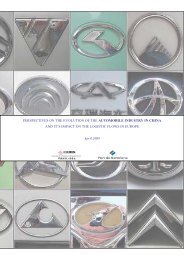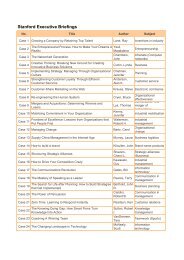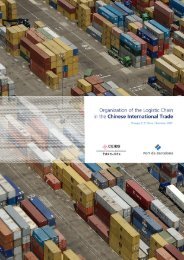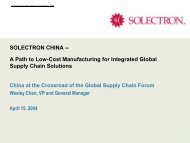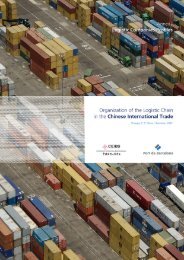Capital Abundance and Developing Country Production Patterns
Capital Abundance and Developing Country Production Patterns
Capital Abundance and Developing Country Production Patterns
You also want an ePaper? Increase the reach of your titles
YUMPU automatically turns print PDFs into web optimized ePapers that Google loves.
approximation in logarithms to the GDP function yields a translog GDP function:<br />
n∑<br />
m∑<br />
lnG = α 0 + α i lnp i + β k lnV k + 1 n∑ n∑<br />
γ ij lnp i lnp j + 1 m∑ m∑<br />
n∑ m∑<br />
δ kl lnV k lnV l + φ ik lnp i lnV k .<br />
2<br />
2<br />
i=1 k=1<br />
i=1 j=1<br />
k=1 l=1<br />
i=1 k=1<br />
(4)<br />
Differentiating (4) with respect to lnp i yields an output share equation:<br />
n∑<br />
m∑<br />
s i = α i + γ ij lnp j + φ ik lnV k , (5)<br />
j=1<br />
k=1<br />
where s i ≡ dlnG/dlnp i = p i Y i /G i is the value-added share of good i in GDP. Note that homogeneity<br />
properties imply ∑ n<br />
i=1 α i =1, ∑ n<br />
j=1 γ ij = 0, <strong>and</strong> ∑ m<br />
k=1 φ ik =0.<br />
3.1 Modeling Technology <strong>and</strong> Price Differences<br />
So far we have been describing a single country with time-invariant technologies <strong>and</strong> commodity<br />
prices. To isolate the effects of factor endowments on production patterns, we need to consider<br />
differences in technologies <strong>and</strong> good prices across country <strong>and</strong> over time. We start by following<br />
Harrigan (1987) in using an nx1 vector Θ to capture sector-specific Hicks-neutral technology<br />
differences across countries (assumed constant over time).<br />
In this case the GDP function is<br />
written as G = G(θ 1 p 1 ,θ 2 p 2 , ...θ n p n ,V 1 ,V 2 , ...V m ), where θ i is an element of Θ. Using c as a<br />
country subscript <strong>and</strong> t a time subscript we write the output share equation as<br />
n∑<br />
m∑<br />
s ict = α i + b ic + γ ij lnp jct + φ ik lnV kct , (6)<br />
j=1<br />
k=1<br />
where b ic ≡ ∑ n<br />
j=1 γ ij lnθ jct is a country-specific constant that captures industry-specific Hicksneutral<br />
technology differences across countries.<br />
There are still non-neutral technology differences across countries <strong>and</strong> technology differences<br />
across time. There are also differences in domestic good prices across countries <strong>and</strong> over time<br />
due to trade barriers. To capture these differences, we follow Harrigan <strong>and</strong> Zakrajšek (2000) to<br />
use an approximation for the price summation term in equation (6):<br />
9




